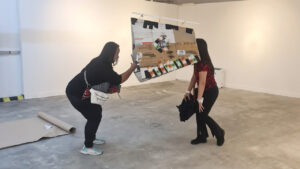THE PERVASIVE influence of screens and digital encounters has dramatically affected people’s perception of art (for better or for worse), something that was further aggravated by the pandemic.
To rekindle the joy of seeing art in person, diverse facets of contemporary photography are currently displayed in the exhibition titled “Braille for the Seeing” at the Cultural Center of the Philippines’ (CCP) Bulwagang Roberto Chabet.
The featured artists in the group exhibit are Poklong Anading, Idan Cruz, Teo Esguerra, Angel Flores, Neo Maestro, Rhaz Oriente, Gary-Ross Pastrana, Angela Silva, Gerome Soriano, Jan Sunday, Stephanie Syjuco, Miguel Lorenzo Uy, and MM Yu.
The idea for the exhibit started in 2019, sparked by discussions between Mr. Esguerra and Mr. Soriano about the growing movement away from sensory engagement and towards the digitalization of art appreciation.
The two submitted a proposal to the CCP for an exhibition that would redefine, re-examine, and reimagine photography through sculpture, video, and interactive art. Little did they know that a pandemic would delay everything.
It took more than two years for planning for the exhibition to resume, once the unprecedented disruption to everyone’s lives had died down. Now, the project is as relevant as ever, with a larger group of artists, a new venue, and an audience recently liberated from restrictions.
“Thanks to the deprivation of genuine human interaction over the last three years, we are today just too eager to keep in touch, to read or learn anew from each other. This exhibit can help us open all our senses, not just our eyes that are photosensitive, but every other faculty,” Ariel S.R. Yonzon, associate artistic director of the CCP Production and Exhibition Department, said during the launch early in November.
For “Braille for the Seeing,” artist Teo Esguerra expanded his previous works that used photo paper, instead allowing viewers to participate and apply chemicals to the work to add to it. The piece called Permanence changes every time someone applies something new.
“My previous work had a bottle of spray paint on the side so viewers can spray some black on it. Now, they have the option to scribble and draw anything,” Mr. Esguerra said.
Gerome Soriano’s installation, Kaleido, Misteryoso Seryoso Pilosopo Jusko, is a massive, colorful cardboard kaleidoscope that lets visitors interact with it. Peeking inside allows one to see interesting reflections, which makes for great pictures or selfies.
It is his biggest kaleidoscope to date, with previous ones only reaching handheld size, according to Mr. Soriano.
“Our proposal used to be different because the space was different. All these works adapted to the delay and aligned to the new space. This kaleidoscope, for example, works better in bright, well-lit areas like this,” he said.
Poklong Anading, who just did a three-week artist residency in Gwangju, South Korea, presented his work Untitled (dwelling) which depicts the community he was immersed in during his time there. It is a screen showing images of locals’ fingernails that he painted, which viewers must touch continuously to reveal each full photo.
Mr. Anading said: “I painted, for free, the fingernails of random participants. But the audio component that plays while you touch the images is more important for me. It’s me talking with participants while painting their nails.”
For him, his full integration with the place and the people in the community was a significant contrast with the idea that art is just studio-based.
Meanwhile, MM Yu made Untitled Landscape, a collection of photos shown on a screen that portray images of greenery seeping through the cracks of landscapes being changed. She aims to show how urban progress comes with nature still trying to survive amid all the concrete.
“We’re running out of space and I wanted to delve into how nature is just accommodating us and how cities adapt to so-called progress. I tried to find landscapes in places where there are no more landscapes,” Ms. Yu said.
Reminding viewers of the great change in human behavior due to digitalization is Rhaz Oriente’s Iris Insight. It is a series of printed photos that show close-ups of people’s irises while they’re using gadgets.
She explained to BusinessWorld that, be it a cellphone or laptop, it was possible to catch the image of the eye bathed in blue light.
“I used a macro lens to focus on the irises of people, to the point that you’re not sure what you’re looking at anymore. It’s like an up-close documentation of people,” she said.
“Braille for the Seeing” is on view at the CCP’s Bulwagang Roberto Chabet, at the third floor of the Tanghalang Ignacio B. Gimenez (CCP Blackbox Theater) at the CCP Complex in Pasay City. The exhibit runs until Dec. 10. — Brontë H. Lacsamana
